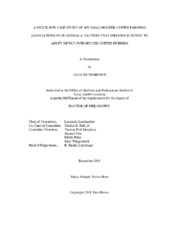| dc.description.abstract | Coffee, especially the Arabica species (Coffea arabica), represents a crucial source of income for millions of producers globally, and is especially important to resource-poor populations in Central America. The coffee leaf rust fungus has negatively impacted production both historically and recently, dramatically reducing profitability and in some cases wiping out entire industries. Projections of climate change show increasingly ideal conditions for coffee rust in coming years. These effects have severe impact on smallholders, an important faction of the global coffee industry. Sustainable intensification using improved varieties is the most recommended method to support smallholders facing these challenges. However, it has been well documented that resource-poor farmers are often hesitant to adopt new technologies and struggle to make beneficial long-range decisions. Decision-making becomes more challenging in perennial systems and further exacerbated under pressure from climate change. Factors affecting intent to adopt newly introduced coffee hybrids were identified through focus groups, held with the six smallholder coffee farming associations involved in the Sustainable Incomes through Coffee Farming Improvement project in San Pedro Yepocapa, Guatemala.
Methods were designed following the Participatory Rural Appraisal approach, to maximize participation and capacity building of subjects. A total of 12 focus groups were held, collecting data from 107 participants across the six associations. Twelve themes were identified, eight representing obstacles to production and sale of coffee and four related to characteristics of the project. Identified obstacles to production and sale of coffee included: low and variable coffee prices, limited market access, high costs of coffee transport and field management, debt and lack of land title, access to processing and drying facilities, lack of education and planning, natural factors, and theft of coffee. Identified project characteristics were: past development in the region, confusion between the terms “hybrid” and “GMO”, plantlet health, and processing facility. By examining these themes through the lens of Rogers’ model of innovation decision-making, we aimed to move the needle towards closing the gap in knowledge about what factors, if any, have substantial impact on perception-forming processes of smallholder coffee farmers towards coffee hybrids introduced via development intervention. | en |


